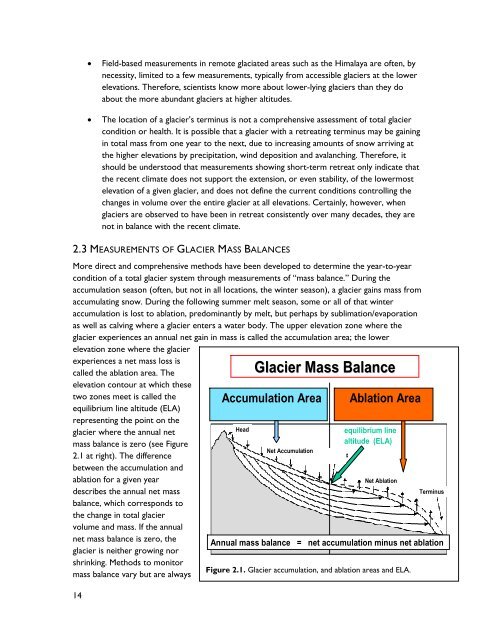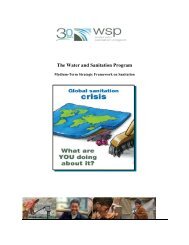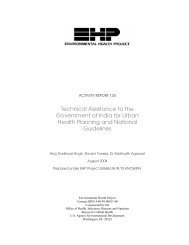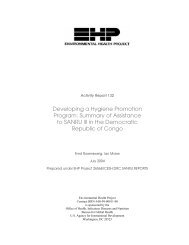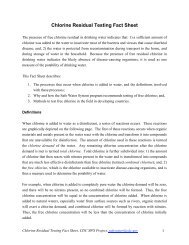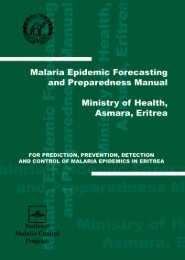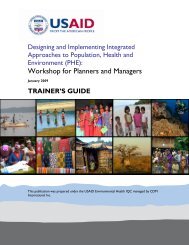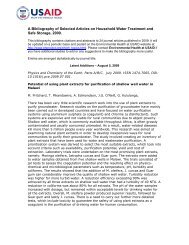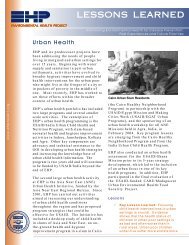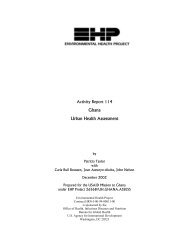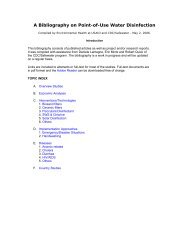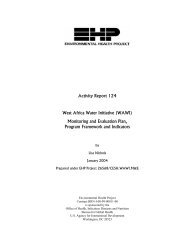Changing Glaciers and Hydrology in Asia - Environmental Health at ...
Changing Glaciers and Hydrology in Asia - Environmental Health at ...
Changing Glaciers and Hydrology in Asia - Environmental Health at ...
- No tags were found...
You also want an ePaper? Increase the reach of your titles
YUMPU automatically turns print PDFs into web optimized ePapers that Google loves.
Field-based measurements <strong>in</strong> remote glaci<strong>at</strong>ed areas such as the Himalaya are often, bynecessity, limited to a few measurements, typically from accessible glaciers <strong>at</strong> the lowerelev<strong>at</strong>ions. Therefore, scientists know more about lower-ly<strong>in</strong>g glaciers than they doabout the more abundant glaciers <strong>at</strong> higher altitudes.The loc<strong>at</strong>ion of a glacier’s term<strong>in</strong>us is not a comprehensive assessment of total glaciercondition or health. It is possible th<strong>at</strong> a glacier with a retre<strong>at</strong><strong>in</strong>g term<strong>in</strong>us may be ga<strong>in</strong><strong>in</strong>g<strong>in</strong> total mass from one year to the next, due to <strong>in</strong>creas<strong>in</strong>g amounts of snow arriv<strong>in</strong>g <strong>at</strong>the higher elev<strong>at</strong>ions by precipit<strong>at</strong>ion, w<strong>in</strong>d deposition <strong>and</strong> avalanch<strong>in</strong>g. Therefore, itshould be understood th<strong>at</strong> measurements show<strong>in</strong>g short-term retre<strong>at</strong> only <strong>in</strong>dic<strong>at</strong>e th<strong>at</strong>the recent clim<strong>at</strong>e does not support the extension, or even stability, of the lowermostelev<strong>at</strong>ion of a given glacier, <strong>and</strong> does not def<strong>in</strong>e the current conditions controll<strong>in</strong>g thechanges <strong>in</strong> volume over the entire glacier <strong>at</strong> all elev<strong>at</strong>ions. Certa<strong>in</strong>ly, however, whenglaciers are observed to have been <strong>in</strong> retre<strong>at</strong> consistently over many decades, they arenot <strong>in</strong> balance with the recent clim<strong>at</strong>e.2.3 MEASUREMENTS OF GLACIER MASS BALANCESMore direct <strong>and</strong> comprehensive methods have been developed to determ<strong>in</strong>e the year-to-yearcondition of a total glacier system through measurements of “mass balance.” Dur<strong>in</strong>g theaccumul<strong>at</strong>ion season (often, but not <strong>in</strong> all loc<strong>at</strong>ions, the w<strong>in</strong>ter season), a glacier ga<strong>in</strong>s mass fromaccumul<strong>at</strong><strong>in</strong>g snow. Dur<strong>in</strong>g the follow<strong>in</strong>g summer melt season, some or all of th<strong>at</strong> w<strong>in</strong>teraccumul<strong>at</strong>ion is lost to abl<strong>at</strong>ion, predom<strong>in</strong>antly by melt, but perhaps by sublim<strong>at</strong>ion/evapor<strong>at</strong>ionas well as calv<strong>in</strong>g where a glacier enters a w<strong>at</strong>er body. The upper elev<strong>at</strong>ion zone where theglacier experiences an annual net ga<strong>in</strong> <strong>in</strong> mass is called the accumul<strong>at</strong>ion area; the lowerelev<strong>at</strong>ion zone where the glacierexperiences a net mass loss iscalled the abl<strong>at</strong>ion area. Theelev<strong>at</strong>ion contour <strong>at</strong> which thesetwo zones meet is called theequilibrium l<strong>in</strong>e altitude (ELA)represent<strong>in</strong>g the po<strong>in</strong>t on theglacier where the annual netmass balance is zero (see Figure2.1 <strong>at</strong> right). The differencebetween the accumul<strong>at</strong>ion <strong>and</strong>abl<strong>at</strong>ion for a given yeardescribes the annual net massbalance, which corresponds tothe change <strong>in</strong> total glaciervolume <strong>and</strong> mass. If the annualnet mass balance is zero, theglacier is neither grow<strong>in</strong>g norshr<strong>in</strong>k<strong>in</strong>g. Methods to monitormass balance vary but are always14Glacier Mass BalanceAccumul<strong>at</strong>ion AreaHeadNet Accumul<strong>at</strong>ionArmstrong, NSIDC/U. of ColoradoAbl<strong>at</strong>ion Areaequilibrium l<strong>in</strong>ealtitude (ELA)Net Abl<strong>at</strong>ionTerm<strong>in</strong>usAnnual mass balance = net accumul<strong>at</strong>ion m<strong>in</strong>us net abl<strong>at</strong>ionFigure 2.1. Glacier accumul<strong>at</strong>ion, <strong>and</strong> abl<strong>at</strong>ion areas <strong>and</strong> ELA.s


